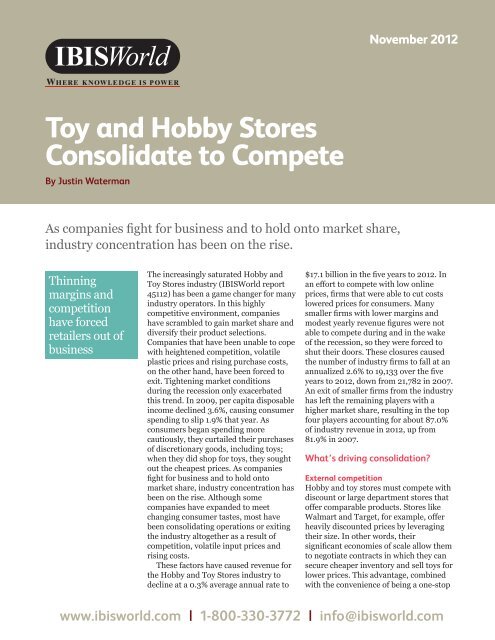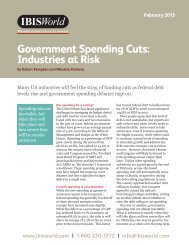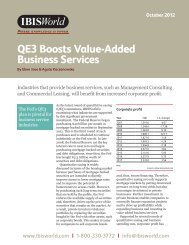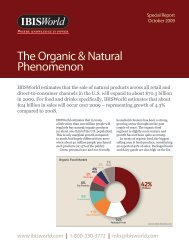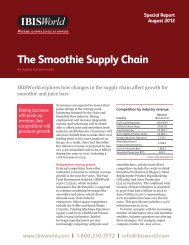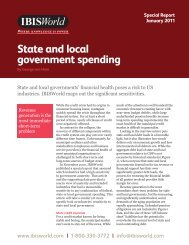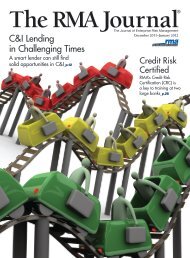Toy and Hobby Stores Consolidate to Compete - IBISWorld
Toy and Hobby Stores Consolidate to Compete - IBISWorld
Toy and Hobby Stores Consolidate to Compete - IBISWorld
You also want an ePaper? Increase the reach of your titles
YUMPU automatically turns print PDFs into web optimized ePapers that Google loves.
WWW.IBISWORLD.COM November 2012 1<br />
<strong>Toy</strong> <strong>and</strong> <strong>Hobby</strong> <strong>S<strong>to</strong>res</strong> <strong>Consolidate</strong> <strong>to</strong> <strong>Compete</strong><br />
<strong>Toy</strong> <strong>and</strong> <strong>Hobby</strong> <strong>S<strong>to</strong>res</strong><br />
<strong>Consolidate</strong> <strong>to</strong> <strong>Compete</strong><br />
By Justin Waterman<br />
As companies fight for business <strong>and</strong> <strong>to</strong> hold on<strong>to</strong> market share,<br />
industry concentration has been on the rise.<br />
Thinning<br />
margins <strong>and</strong><br />
competition<br />
have forced<br />
retailers out of<br />
business<br />
The increasingly saturated <strong>Hobby</strong> <strong>and</strong><br />
<strong>Toy</strong> <strong>S<strong>to</strong>res</strong> industry (<strong>IBISWorld</strong> report<br />
45112) has been a game changer for many<br />
industry opera<strong>to</strong>rs. In this highly<br />
competitive environment, companies<br />
have scrambled <strong>to</strong> gain market share <strong>and</strong><br />
diversify their product selections.<br />
Companies that have been unable <strong>to</strong> cope<br />
with heightened competition, volatile<br />
plastic prices <strong>and</strong> rising purchase costs,<br />
on the other h<strong>and</strong>, have been forced <strong>to</strong><br />
exit. Tightening market conditions<br />
during the recession only exacerbated<br />
this trend. In 2009, per capita disposable<br />
income declined 3.6%, causing consumer<br />
spending <strong>to</strong> slip 1.9% that year. As<br />
consumers began spending more<br />
cautiously, they curtailed their purchases<br />
of discretionary goods, including <strong>to</strong>ys;<br />
when they did shop for <strong>to</strong>ys, they sought<br />
out the cheapest prices. As companies<br />
fight for business <strong>and</strong> <strong>to</strong> hold on<strong>to</strong><br />
market share, industry concentration has<br />
been on the rise. Although some<br />
companies have exp<strong>and</strong>ed <strong>to</strong> meet<br />
changing consumer tastes, most have<br />
been consolidating operations or exiting<br />
the industry al<strong>to</strong>gether as a result of<br />
competition, volatile input prices <strong>and</strong><br />
rising costs.<br />
These fac<strong>to</strong>rs have caused revenue for<br />
the <strong>Hobby</strong> <strong>and</strong> <strong>Toy</strong> <strong>S<strong>to</strong>res</strong> industry <strong>to</strong><br />
decline at a 0.3% average annual rate <strong>to</strong><br />
November 2012<br />
$17.1 billion in the five years <strong>to</strong> 2012. In<br />
an effort <strong>to</strong> compete with low online<br />
prices, firms that were able <strong>to</strong> cut costs<br />
lowered prices for consumers. Many<br />
smaller firms with lower margins <strong>and</strong><br />
modest yearly revenue figures were not<br />
able <strong>to</strong> compete during <strong>and</strong> in the wake<br />
of the recession, so they were forced <strong>to</strong><br />
shut their doors. These closures caused<br />
the number of industry firms <strong>to</strong> fall at an<br />
annualized 2.6% <strong>to</strong> 19,133 over the five<br />
years <strong>to</strong> 2012, down from 21,782 in 2007.<br />
An exit of smaller firms from the industry<br />
has left the remaining players with a<br />
higher market share, resulting in the <strong>to</strong>p<br />
four players accounting for about 87.0%<br />
of industry revenue in 2012, up from<br />
81.9% in 2007.<br />
What’s driving consolidation?<br />
External competition<br />
<strong>Hobby</strong> <strong>and</strong> <strong>to</strong>y s<strong>to</strong>res must compete with<br />
discount or large department s<strong>to</strong>res that<br />
offer comparable products. <strong>S<strong>to</strong>res</strong> like<br />
Walmart <strong>and</strong> Target, for example, offer<br />
heavily discounted prices by leveraging<br />
their size. In other words, their<br />
significant economies of scale allow them<br />
<strong>to</strong> negotiate contracts in which they can<br />
secure cheaper inven<strong>to</strong>ry <strong>and</strong> sell <strong>to</strong>ys for<br />
lower prices. This advantage, combined<br />
with the convenience of being a one-s<strong>to</strong>p<br />
www.ibisworld.com | 1-800-330-3772 | info@ibisworld.com
WWW.IBISWORLD.COM November 2012 2<br />
<strong>Toy</strong> <strong>and</strong> <strong>Hobby</strong> <strong>S<strong>to</strong>res</strong> <strong>Consolidate</strong> <strong>to</strong> <strong>Compete</strong><br />
% Growth in share of economy<br />
20<br />
15<br />
10<br />
5<br />
0<br />
–5<br />
Maturity<br />
Company<br />
consolidation;<br />
level of economic<br />
importance stable<br />
<strong>Hobby</strong> &<br />
<strong>Toy</strong> <strong>S<strong>to</strong>res</strong><br />
shop for a variety of household items, has<br />
restricted growth in the <strong>Hobby</strong> <strong>and</strong> <strong>Toy</strong><br />
<strong>S<strong>to</strong>res</strong> industry. By increasing their size,<br />
however, hobby <strong>and</strong> <strong>to</strong>y s<strong>to</strong>res can offer<br />
lower prices by buying in bulk <strong>and</strong> can<br />
provide a product range that is more<br />
diverse than most of their external<br />
Quality Growth<br />
High growth in economic<br />
importance; weaker companies<br />
close down; developed<br />
technology <strong>and</strong> markets<br />
Used Goods <strong>S<strong>to</strong>res</strong><br />
<strong>Toy</strong> & Craft Supplies Wholesaling<br />
Computer <strong>S<strong>to</strong>res</strong><br />
Fabric, Craft & Sewing<br />
Supplies <strong>S<strong>to</strong>res</strong><br />
<strong>Toy</strong>, Doll & Game Manufacturing<br />
–10<br />
–10 –5 0 5<br />
10 15<br />
20<br />
competi<strong>to</strong>rs. This strategy has gained the<br />
attention of hobby <strong>and</strong> <strong>to</strong>y retailers over<br />
recent years <strong>and</strong> is expected <strong>to</strong> turn<br />
industry revenue around, pushing it up<br />
0.5% <strong>to</strong> $17.1 billion in 2012.<br />
Further competition stems from online<br />
retailers of <strong>to</strong>ys <strong>and</strong> hobby goods, which<br />
Key Features of a Mature Industry<br />
Revenue grows at same pace as economy<br />
Company numbers stabilize; M&A stage<br />
Established technology & processes<br />
Total market acceptance of product & br<strong>and</strong><br />
Rationalization of low margin products & br<strong>and</strong>s<br />
Quantity Growth<br />
Many new companies;<br />
minor growth in economic<br />
importance; substantial<br />
technology change<br />
Decline<br />
Shrinking economic<br />
importance<br />
% Growth in number of establishments<br />
SOURCE: WWW.IBISWORLD.COM
WWW.IBISWORLD.COM November 2012 3<br />
<strong>Toy</strong> <strong>and</strong> <strong>Hobby</strong> <strong>S<strong>to</strong>res</strong> <strong>Consolidate</strong> <strong>to</strong> <strong>Compete</strong><br />
do not generate revenue for this industry.<br />
Online sales of <strong>to</strong>ys <strong>and</strong> hobby goods<br />
have risen in popularity because they<br />
make shopping for the cheapest <strong>to</strong>ys <strong>and</strong><br />
hobby goods more convenient. First, with<br />
fewer or no brick-<strong>and</strong>-mortar<br />
establishments, overhead costs are lower<br />
<strong>and</strong> the e-tailer can pass on cost savings<br />
<strong>to</strong> consumers. In addition, cus<strong>to</strong>mers can<br />
browse through a variety of sites for the<br />
cheapest goods.<br />
Already, the trend has forced some<br />
smaller <strong>to</strong>y s<strong>to</strong>res <strong>to</strong> exit the industry,<br />
leaving behind larger firms <strong>to</strong> fulfill<br />
consumer dem<strong>and</strong>.<br />
Volatile plastic prices trim margins<br />
Plastic <strong>and</strong> resin materials are key inputs<br />
in the <strong>Toy</strong>, Doll <strong>and</strong> Game Manufacturing<br />
industry (<strong>IBISWorld</strong> report 33993),<br />
which produces <strong>to</strong>ys <strong>and</strong> hobby items. A<br />
rise in the price of plastic <strong>and</strong> resin<br />
ripples through the supply chain, making<br />
<strong>to</strong>y production more expensive for<br />
manufacturers. These manufacturers<br />
then sell these <strong>to</strong>ys for a higher price <strong>to</strong><br />
the <strong>Toy</strong> <strong>and</strong> Craft Supplies Wholesaling<br />
industry (42392), which then charges<br />
higher prices <strong>to</strong> <strong>to</strong>y <strong>and</strong> hobby shop<br />
owners, thinning their margins.<br />
This scenario has surfaced over the<br />
past five years, with the price of plastic<br />
materials <strong>and</strong> resin rising at an average<br />
annual rate of 3.5%, according <strong>to</strong> the<br />
Bureau of Labor Statistics. This ascent<br />
includes a 9.8% spike in 2008 that<br />
hampered industry profitability.<br />
Thinning margins rendered some firms<br />
out of commission <strong>and</strong> helped contribute<br />
<strong>to</strong> a 5.0% decline in the number of <strong>to</strong>y<br />
shops that year. Although industry firms<br />
reduced the number of s<strong>to</strong>res <strong>and</strong><br />
employees <strong>to</strong> slow margin declines,<br />
rising input costs caused industry profit<br />
<strong>to</strong> fall from 2.6% of industry revenue in<br />
2007 <strong>to</strong> an estimated 2.0% in 2012.<br />
Greener pastures lie ahead for the<br />
industry, however; due <strong>to</strong> rising<br />
disposable income <strong>and</strong> further industry<br />
consolidation, profit margins are forecast<br />
<strong>to</strong> exp<strong>and</strong> <strong>to</strong> 2.5% in 2017.<br />
High-tech products raise purchase costs<br />
The <strong>Hobby</strong> <strong>and</strong> <strong>Toy</strong> <strong>S<strong>to</strong>res</strong> industry<br />
provides a variety of products <strong>and</strong><br />
services for children <strong>and</strong> adults alike.<br />
<strong>IBISWorld</strong> separates the industry’s<br />
products in<strong>to</strong> four groups: traditional<br />
<strong>to</strong>ys, youth electronics, other <strong>to</strong>ys <strong>and</strong><br />
games, <strong>and</strong> hobby <strong>and</strong> craft supplies. The<br />
youth electronics segment has gained<br />
popularity over the past five years with<br />
the onset of age compression, which is<br />
the phenomenon of younger children<br />
desiring <strong>to</strong>ys traditionally reserved for<br />
older individuals. More advanced <strong>to</strong>ys<br />
are typically electronic in nature, <strong>and</strong><br />
thus require semiconduc<strong>to</strong>rs. Research<br />
<strong>and</strong> development costs of manufacturing<br />
these advanced <strong>to</strong>ys are significant <strong>and</strong><br />
typically passed on <strong>to</strong> industry opera<strong>to</strong>rs.<br />
The rapid <strong>and</strong> sudden rise of age<br />
compression significantly raised the<br />
purchase costs of smaller opera<strong>to</strong>rs who<br />
could not leverage economies of scale.<br />
Firms without large cash reserves or<br />
access <strong>to</strong> credit could not purchase these<br />
expensive <strong>to</strong>ys <strong>and</strong> thus could not<br />
properly satisfy consumer dem<strong>and</strong>. Such<br />
<strong>to</strong>y s<strong>to</strong>res were forced <strong>to</strong> close shop,<br />
further fueling industry consolidation.<br />
Strategies <strong>to</strong> exp<strong>and</strong> market share<br />
Acquiring competi<strong>to</strong>rs<br />
Some firms, including major player<br />
<strong>Toy</strong>s ‘R’ Us, have acquired other<br />
industry firms in an effort <strong>to</strong> exp<strong>and</strong><br />
their product lines, market penetration<br />
<strong>and</strong> geographic reach. While firms may<br />
have a sizeable number of products at<br />
their s<strong>to</strong>res, there is always another<br />
firm that s<strong>to</strong>cks different products. By<br />
acquiring a variety of s<strong>to</strong>res in the<br />
industry, a firm can exp<strong>and</strong> its product<br />
offerings, driving more traffic <strong>to</strong> their<br />
s<strong>to</strong>res. Further, buying out s<strong>to</strong>res in
WWW.IBISWORLD.COM November 2012 4<br />
<strong>Toy</strong> <strong>and</strong> <strong>Hobby</strong> <strong>S<strong>to</strong>res</strong> <strong>Consolidate</strong> <strong>to</strong> <strong>Compete</strong><br />
areas where the acquirer is not already<br />
present boosts market share by<br />
capturing cus<strong>to</strong>mers in that region.<br />
Organically gaining market share<br />
Another way firms gain market share is<br />
through organic growth. During <strong>and</strong> in<br />
the wake of the recession, per capita<br />
disposable income <strong>and</strong> consumer<br />
sentiment fell. In 2008 in particular,<br />
consumer sentiment plummeted 25.5%,<br />
<strong>and</strong> in 2009, average disposable income<br />
fell 3.2%. Because <strong>to</strong>y purchases are<br />
highly discretionary, consumers curtailed<br />
their spending on these items,<br />
particularly on more expensive (<strong>and</strong><br />
usually higher-margin) <strong>to</strong>ys <strong>and</strong> hobbies.<br />
These new habits cut heavily in<strong>to</strong><br />
margins <strong>and</strong> caused underperforming<br />
firms <strong>to</strong> exit the industry. With smaller<br />
firms out of the picture, the remaining<br />
firms absorbed the market share once<br />
held by out-of-business firms, increasing<br />
the average firm’s market share.<br />
Recent M&A activity<br />
<strong>Toy</strong>s ‘R’ Us changes its structure<br />
In 2009, <strong>Toy</strong>s ‘R’ Us, the industry’s<br />
largest player, acquired troubled<br />
competi<strong>to</strong>r KB <strong>Toy</strong>s. Although KB’s 460<br />
s<strong>to</strong>res were shut down that year, <strong>Toy</strong>s ‘R’<br />
Us became the owner of KB’s logo <strong>and</strong><br />
web address. During the same year, <strong>Toy</strong>s<br />
‘R’ Us operated 849 domestic s<strong>to</strong>res, with<br />
each s<strong>to</strong>re generating an average of $9.9<br />
million. Since then, the company has<br />
slashed its s<strong>to</strong>re count by about half. This<br />
move is in line with the company’s goal of<br />
shifting <strong>to</strong> a lower ratio of seasonal s<strong>to</strong>res<br />
<strong>to</strong> year-round s<strong>to</strong>res, with the seasonal<br />
s<strong>to</strong>res open only during heavy shopping<br />
seasons. As of January 2012, the<br />
company operated 351 domestic s<strong>to</strong>res,<br />
with the average establishment<br />
generating $24.0 million, or more than<br />
double what each s<strong>to</strong>re generated two<br />
years prior. This phenomenon occurred<br />
because although the s<strong>to</strong>re count halved,<br />
<strong>Hobby</strong> <strong>and</strong> <strong>Toy</strong> <strong>S<strong>to</strong>res</strong> Risk Rating<br />
Risk component Weight Score<br />
Structural risk 25% 4.77<br />
Growth risk 25% 5.34<br />
Sensitivity risk 50% 4.74<br />
Overall risk 4.90<br />
dem<strong>and</strong> remained relatively stable for<br />
<strong>to</strong>ys <strong>and</strong> hobby goods from brick-<strong>and</strong>mortar<br />
s<strong>to</strong>res, <strong>and</strong> the remaining 351<br />
s<strong>to</strong>res satisfied this dem<strong>and</strong>.<br />
While the company is expected <strong>to</strong> be<br />
more efficient over 2012, with domestic<br />
profit rising about $6.0 million, the cut in<br />
the number of s<strong>to</strong>res will slightly reduce<br />
the company’s market share <strong>to</strong> 47.7%<br />
(down from 47.8% in 2007). Only sales of<br />
<strong>to</strong>ys <strong>and</strong> hobby supplies from physical<br />
s<strong>to</strong>re locations, as opposed <strong>to</strong> online sites,<br />
contribute <strong>to</strong> this market share. Revenue<br />
from the company’s consolidated<br />
operations, however, including online<br />
sales of <strong>to</strong>ys <strong>and</strong> hobby supplies, are<br />
expected <strong>to</strong> rise 1.0% over 2012 <strong>to</strong> $14.1<br />
billion. Larger opera<strong>to</strong>rs across the<br />
industry are expected <strong>to</strong> follow suit <strong>and</strong><br />
reduce their number of establishments,<br />
contributing <strong>to</strong> an expected average<br />
annual 3.0% decline in the number of <strong>to</strong>y<br />
<strong>and</strong> hobby s<strong>to</strong>res in the United States in<br />
the five years <strong>to</strong> 2012.<br />
Risk fac<strong>to</strong>rs<br />
SOURCE: WWW.IBISWORLD.COM<br />
Overall risk in the <strong>Hobby</strong> <strong>and</strong> <strong>Toy</strong> <strong>S<strong>to</strong>res</strong><br />
industry is forecast <strong>to</strong> be moderate over<br />
2013, with a score of 4.9 out of 9. Growth<br />
risk, in particular, is expected <strong>to</strong> be high in<br />
2013, scoring 5.3 points <strong>and</strong> accounting<br />
for one-fourth of the score. <strong>IBISWorld</strong><br />
estimates that revenue will grow 0.5% <strong>to</strong><br />
$17.1 billion over 2012, slower growth<br />
than 2010 <strong>and</strong> 2011. The primary reasons<br />
for this slowdown are the rising <strong>and</strong><br />
volatile prices of plastic <strong>and</strong> steel, <strong>and</strong>
WWW.IBISWORLD.COM November 2012 5<br />
<strong>Toy</strong> <strong>and</strong> <strong>Hobby</strong> <strong>S<strong>to</strong>res</strong> <strong>Consolidate</strong> <strong>to</strong> <strong>Compete</strong><br />
About <strong>IBISWorld</strong> Inc.<br />
Recognized as the nation’s<br />
most trusted independent<br />
source of industry <strong>and</strong><br />
market research, <strong>IBISWorld</strong><br />
offers a comprehensive<br />
database of unique<br />
information <strong>and</strong> analysis on<br />
every US industry. With an<br />
extensive online portfolio,<br />
valued for its depth <strong>and</strong><br />
scope, the company equips<br />
clients with the insight<br />
necessary <strong>to</strong> make better<br />
business decisions.<br />
Headquartered in<br />
Los Angeles, <strong>IBISWorld</strong><br />
serves a range of business,<br />
professional service <strong>and</strong><br />
government organizations<br />
through more than<br />
10 locations worldwide.<br />
For more information, visit<br />
www.ibisworld.com or call<br />
1-800-330-3772.<br />
v<br />
Contact:<br />
Savannah Haspel<br />
VP, Public Relations<br />
<strong>IBISWorld</strong><br />
Phone: 1-310-866-5044<br />
savannahh@ibisworld.com<br />
www.ibisworld.com<br />
Risk rating<br />
<strong>Hobby</strong> <strong>and</strong> <strong>Toy</strong> <strong>S<strong>to</strong>res</strong> Risk Rating<br />
6.5<br />
6.0<br />
5.5<br />
5.0<br />
4.5<br />
4.0<br />
Year 04 05 06 07 08 09 10<br />
mounting external competition from the<br />
online retailing sec<strong>to</strong>r. Such pressures<br />
have caused industry participants <strong>to</strong><br />
consolidate by shutting down s<strong>to</strong>res <strong>to</strong> cut<br />
overhead costs. Others have downsized,<br />
reducing the square footage of each s<strong>to</strong>re,<br />
thereby lowering rent <strong>and</strong> utilities costs.<br />
With fewer square feet <strong>to</strong> manage, some<br />
workers in the industry have been laid off.<br />
Over the past five years, employment fell<br />
at an estimated average annual rate of<br />
1.3% <strong>to</strong> 142,298 employees, down from<br />
151, 606 in 2007.<br />
Consolidation <strong>to</strong> come<br />
In the coming years, revenue is expected<br />
<strong>to</strong> grow strongly on the back of strategic<br />
s<strong>to</strong>re placement in heavy-traffic shopping<br />
Benchmarking performance metrics<br />
centers <strong>and</strong> rises in consumer spending.<br />
During the five years <strong>to</strong> 2017, industry<br />
revenue is forecast <strong>to</strong> rise at an annualized<br />
0.6% <strong>to</strong> $17.6 billion. At the same time,<br />
the number of <strong>to</strong>y <strong>and</strong> hobby s<strong>to</strong>re firms is<br />
expected <strong>to</strong> fall at an average annual rate<br />
of 1.1% <strong>to</strong> 18,145. As <strong>to</strong>ys become more<br />
expensive <strong>to</strong> produce (stemming from<br />
rising plastic <strong>and</strong> steel costs), smaller<br />
firms will choose or be forced <strong>to</strong> shut their<br />
doors, exacerbating the industry’s present<br />
consolidation activity. As the largest<br />
players in the industry use their reserves<br />
<strong>to</strong> open an increasing number of seasonal<br />
s<strong>to</strong>res (the prime selling season), they will<br />
gain market share. Consequently, the <strong>to</strong>p<br />
four companies in the industry are<br />
forecast <strong>to</strong> account for 89.3% of industry<br />
revenue in 2017, up from 87.0% in 2012.<br />
Jo-Ann <strong>S<strong>to</strong>res</strong> Inc.: 3.8% Michaels <strong>S<strong>to</strong>res</strong> Inc.: 5.0%<br />
Michaels <strong>S<strong>to</strong>res</strong> Inc.: 3.2% Jo-Ann <strong>S<strong>to</strong>res</strong> Inc.: 0.9% Jo-Ann <strong>S<strong>to</strong>res</strong> Inc.: 4.5%<br />
Annual Growth: -0.3%* Revenue volatility: 2.2%* Net Income: 3.4%*<br />
<strong>Toy</strong>s ‘R’ Us Inc.: -0.7% Michaels <strong>S<strong>to</strong>res</strong> Inc.: 2.6% <strong>Toy</strong>s ‘R’ Us Inc.: 1.2%<br />
*Industry average<br />
<strong>Toy</strong>s ‘R’ Us Inc.: 2.6%<br />
11 12 13<br />
Industry risk Division Risk: Retail Trade Economy Risk: Entire US Economy<br />
SOURCE: IBISWORLD<br />
SOURCE: IBISWORLD
www.ibisworld.com | 1-800-330-3772 | info@ibisworld.com<br />
At <strong>IBISWorld</strong> we know that industry intelligence<br />
is more than assembling facts. It is combining<br />
data with analysis <strong>to</strong> answer the questions that<br />
successful businesses ask.<br />
Identify high growth, emerging <strong>and</strong> shrinking markets<br />
Arm yourself with the latest industry intelligence<br />
Assess competitive threats from existing <strong>and</strong> new entrants<br />
Benchmark your performance against the competition<br />
Make speedy market-ready, profit-maximizing decisions<br />
Disclaimer<br />
This product has been supplied by <strong>IBISWorld</strong> Inc. (‘<strong>IBISWorld</strong>’) solely for use<br />
by its authorized licenses strictly in accordance with their license agreements<br />
with <strong>IBISWorld</strong>. <strong>IBISWorld</strong> makes no representation <strong>to</strong> any other person<br />
with regard <strong>to</strong> the completeness or accuracy of the data or information<br />
contained herein, <strong>and</strong> it accepts no responsibility <strong>and</strong> disclaims all liability<br />
(save for liability which cannot be lawfully disclaimed) for loss or damage<br />
whatsoever suffered or incurred by any other person resulting from the use<br />
Who is <strong>IBISWorld</strong>?<br />
We are strategists, analysts, researchers <strong>and</strong> marketers. We provide<br />
answers <strong>to</strong> information-hungry, time-poor businesses. Our goal is <strong>to</strong> give<br />
you the real-world answers that matter <strong>to</strong> your business in our 700 US<br />
industry reports. When <strong>to</strong>ugh strategic, budget, sales <strong>and</strong> marketing<br />
decisions need <strong>to</strong> be made, our suite of Industry <strong>and</strong> Risk intelligence<br />
products give you deeply researched answers quickly.<br />
<strong>IBISWorld</strong> Membership<br />
<strong>IBISWorld</strong> offers tailored membership packages <strong>to</strong> meet your needs.<br />
Join <strong>and</strong> become an industry expert!<br />
of, or reliance upon, the data or information contained herein. Copyright in<br />
this publication is owned by <strong>IBISWorld</strong> Inc. The publication is sold on the<br />
basis that the purchaser agrees not <strong>to</strong> copy the material contained within it<br />
for other than the purchasers own purposes. In the event that the purchaser<br />
uses or quotes from the material in this publication – in papers, reports, or<br />
opinions prepared for any other person – it is agreed that it will be sourced<br />
<strong>to</strong>: <strong>IBISWorld</strong> Inc.<br />
© Copyright 2012. <strong>IBISWorld</strong> Inc.


